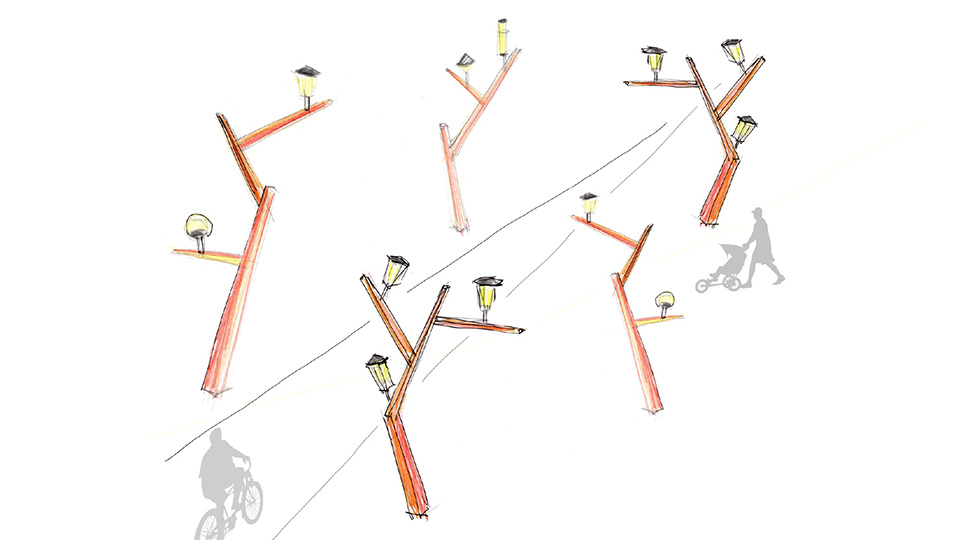Studio Hildebrand
Mag.Art. Christoph Hildebrand
+49 0163 5810594
ch@studio-hildebrand.net




Mag.Art. Christoph Hildebrand
+49 0163 5810594
ch@studio-hildebrand.net










Die Kunstmeile in Recklinghausen besteht aus zwei sehr unterschiedlichen Streckenabschnitten. Während der bereits fertig gestellte erste Teil durch einen Stadtteil mit gepflegten Siedlungshäusern führt, bahnt sich der zweite Teil seinen Weg durch ein renaturiertes ehemaliges Zechengelände, das mit Spontanvegetation dicht bewachsen ist.
Ein Abschnitt, der durch die Errungenschaften und Notwendigkeiten unserer Zivilisation geprägt ist, steht einem Abschnitt gegenüber, der durch den Wildwuchs einer ungezähmten Natur gekennzeichnet ist.
Wildwuchs
Interessanterweise gibt es aber in der perfekt organisierten Siedlung eine eigene Art von „Wildwuchs“. Nach dem Übergang der Häuser in das Eigentum der jetzigen Besitzer, entstand aus der ehemals uniformen Arbeitersiedlung eine hoch individualisierte Agglomeration des heute im Wohnungsbau technisch und gestalterisch Machbaren. Dies äußert sich neben der Gestalt der Haustüren, Zäune oder Dächer im Besonderen auch in der Art der Beleuchtungskörper und der mehr oder weniger exotischen Bepflanzung der Vorgärten.
Das spannende und unterhaltsame Verhältnis von „Wildwuchs“ im urbanen wie im natürlichen Raum ist der Ausgangspunkt für den vorliegenden Entwurf:
In einer surrealen Überkreuzung der beiden Situationen wächst nun auf dem aufgeräumten ersten Teil des Weges, dort wo momentan drei Straßenleuchten etwas erratisch auf einer Wegkreuzung stehen, „wildes Licht“ in Form von exaltierten „Laternenbäumen“. Im verwilderten zweiten Teil des Weges stehen „zahme Bäume“ eingetopft in überdimensionalen Blumentöpfen in einer zwanghaft geordneten „Topfbaumallee“.
Leuchtwald
Im „Leuchtwald“ wachsen Laternen, wie sie sich in einer Vielzahl von Modellen und Varianten in der angrenzenden Siedlung finden, Früchten gleich „wild“ auf expressiven baumartigen Stahlmasten. In der „Topfallee“ werden exotische Bäume, wie sie in vielen Vorgärten der nahen Siedlung zu sehen sind, in riesigen 2m hohen Töpfen in Reih und Glied inmitten der „Wildnis“ des renaturierten Gleisgeländes aufgestellt.
Der Spaziergänger und Radtourist erlebt beim Durchfahren und Durchwandern des situationsbezogenen Kunstwerks ein verkleinertes und humorvolles Spiegelbild der unauflösbaren Polarität von Technik und Natur, eine Polarität, die seit dem Erscheinen des „homo sapiens“ auf unserem Planeten ein konstituierendes Motiv der Zivilisationsgeschichte darstellt – mit all ihren Problemen, Chancen und Konsequenzen.
//
The Art Mile in Recklinghausen consists of two very different sections. While the already completed first section leads through a district with well-kept housing estates, the second section makes its way through a renaturalised former coal mine site that is densely overgrown with spontaneous vegetation.
A section marked by the achievements and necessities of our civilisation contrasts with a section characterised by the wild growth of untamed nature.
Wild growth
Interestingly, however, there is a separate kind of „wild growth“ in the perfectly organised settlement. After the houses became the property of their current owners, the formerly uniform workers‘ settlement became a highly individualised agglomeration of what is technically and creatively feasible in housing today. This is expressed not only in the design of the front doors, fences or roofs in particular, but also in the type of lighting fixtures and the more or less exotic planting of the front gardens.
The exciting and entertaining relationship of „wild growth“ in both urban and natural space is the starting point for the present design:
In a surreal crossing of the two situations, „wild light“ in the form of exalted „lantern trees“ now grows on the tidy first part of the path, where three street lights currently stand somewhat erratically on a crossroads. In the overgrown second part of the path, „tame trees“ stand potted in oversized flower pots in an obsessively ordered „potted tree avenue“.
Leuchtwald
In the „Leuchtwald“, lanterns, as found in a multitude of models and variations in the neighbouring settlement, grow „wild“ like fruits on expressive tree-like steel poles. In the „potted avenue“, exotic trees, such as can be seen in many front gardens of the nearby settlement, are lined up in huge 2m high pots in the middle of the „wilderness“ of the renaturalised track area.
The walker and cycle tourist experiences a scaled-down and humorous reflection of the indissoluble polarity of technology and nature when passing through and wandering through the situational work of art, a polarity that has been a constituent motif of the history of civilisation since the appearance of „homo sapiens“ on our planet – with all its problems, opportunities and consequences.
P R O P O S A L Competition Kunstmeile Recklinghausen 2013 + D E S I G N LEUCHTWALD 8 „Bäume“ / Höhe 4-6m / Gewicht ca. 300kg / Material Aluminium / Leuchten je Baum 3-4 Stück / TOPF-ALLEE 8 Topfbäume / Topfhöhe 1,8m / Durchmesser 2,0m / Material Stahlblech / Beton BÄUME Ginko / Araucaria / Rhododendron / Magnolie / Palme / Zierapfel / Japanischer Ahorn / Lorbeer + S U P P O R T / + M E D I A 6 images © Christoph Hildebrand + T A G S Light / Proposal / Urban / +
